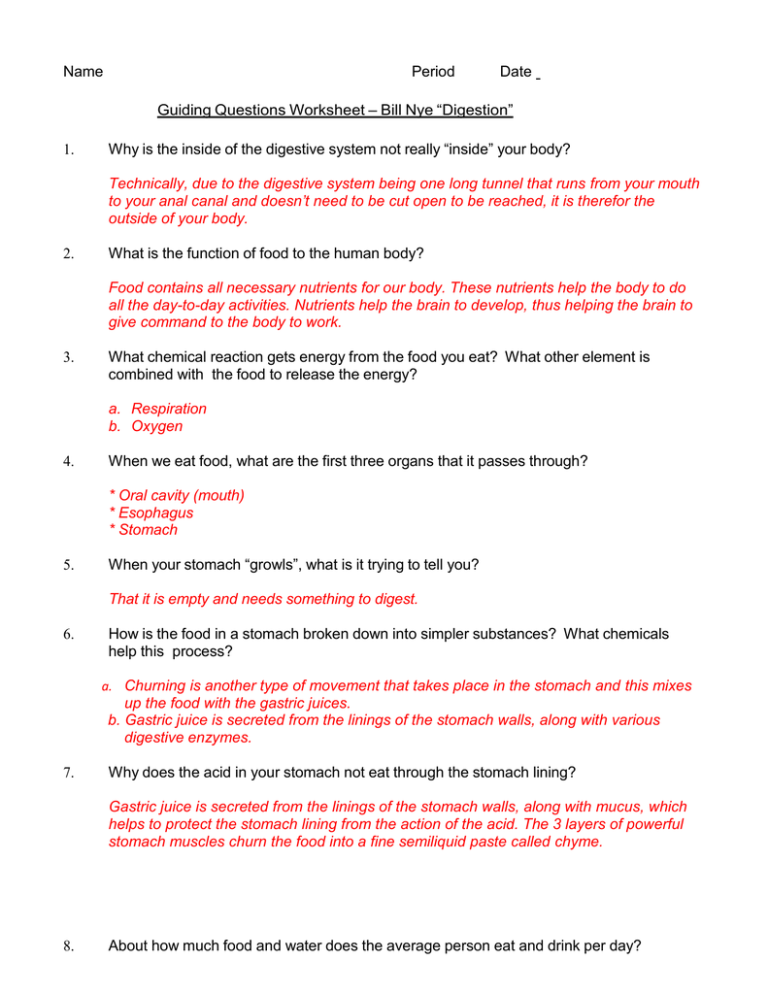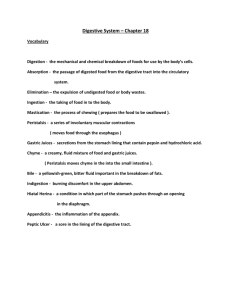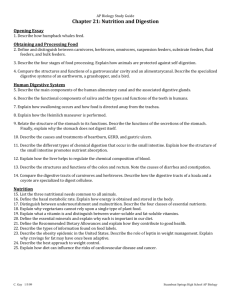Microsoft Word - GQW-BillNye Digestion.doc
advertisement

Name Period Date Guiding Questions Worksheet – Bill Nye “Digestion” 1. Why is the inside of the digestive system not really “inside” your body? Technically, due to the digestive system being one long tunnel that runs from your mouth to your anal canal and doesn’t need to be cut open to be reached, it is therefor the outside of your body. 2. What is the function of food to the human body? Food contains all necessary nutrients for our body. These nutrients help the body to do all the day-to-day activities. Nutrients help the brain to develop, thus helping the brain to give command to the body to work. 3. What chemical reaction gets energy from the food you eat? What other element is combined with the food to release the energy? a. Respiration b. Oxygen 4. When we eat food, what are the first three organs that it passes through? * Oral cavity (mouth) * Esophagus * Stomach 5. When your stomach “growls”, what is it trying to tell you? That it is empty and needs something to digest. 6. How is the food in a stomach broken down into simpler substances? What chemicals help this process? a. Churning is another type of movement that takes place in the stomach and this mixes up the food with the gastric juices. b. Gastric juice is secreted from the linings of the stomach walls, along with various digestive enzymes. 7. Why does the acid in your stomach not eat through the stomach lining? Gastric juice is secreted from the linings of the stomach walls, along with mucus, which helps to protect the stomach lining from the action of the acid. The 3 layers of powerful stomach muscles churn the food into a fine semiliquid paste called chyme. 8. About how much food and water does the average person eat and drink per day? a. Adult Men about 4 L per day and adult Women about 3 l per day. b. Food varies on culture, age, activity level and gender: see below c. According to B. Nye, about 1 kg of food (??) Gender Age (years) Sedentaryb Moderately Activec Actived Child 2-3 1,000 1,000-1,400 1,000-1,400 Female 4-8 9-13 14-18 19-30 31-50 51+ 1,200 1,600 1,800 2,000 1,800 1,600 1,400-1,600 1,600-2,000 2,000 2,000-2,200 2,000 1,800 1,400-1,800 1,800-2,200 2,400 2,400 2,200 2,000-2,200 Male 4-8 9-13 14-18 19-30 31-50 51+ 1,400 1,800 2,200 2,400 2,200 2,000 1,400-1,600 1,800-2,200 2,400-2,800 2,600-2,800 2,400-2,600 2,200-2,400 1,600-2,000 2,000-2,600 2,800-3,200 3,000 2,800-3,000 2,400-2,800 These levels are based on Estimated Energy Requirements (EER) from the Institute of Medicine Dietary Reference Intakes macronutrients report, 2002, calculated by gender, age, and activity level for reference-sized individuals. "Reference size," as determined by IOM, is based on median height and weight for ages up to age 18 years of age and median height and weight for that height to give a BMI of 21.5 for adult females and 22.5 for adult males. a b Sedentary means a lifestyle that includes only the light physical activity associated with typical day-to-day life. Moderately active means a lifestyle that includes physical activity equivalent to walking about 1.5 to 3 miles per day at 3 to 4 miles per hour, in addition to the light physical activity associated with typical day-to-day life c Active means a lifestyle that includes physical activity equivalent to walking more than 3 miles per day at 3 to 4 miles per hour, in addition to the light physical activity associated with typical day-to-day life. d 9. How does the mouth start the process of digestion? The mouth releases saliva that contains digestive enzymes and the tongue and teeth move the food around and grind it up into smaller pieces thus increasing the surface area. 10. How long is the small intestine in adults and children? The small intestine is about 6-7 meters long. It has a surface area of about 30 meters square! 11. How long is the large intestine? About 1.5 – 2 meters 12. How long does it take food to travel through the digestion system? About 12 hours to 2 days 13. Can you swallow food when hanging upside down? What is the name of the process that pushes food down the esophagus? Yes; peristalsis 14. What is the name given to the mix of broken down food and water in the stomach and small intestine? What does the digestive system add to the consumed food and water? Chyme; various enzymes, acid, digestive fluids (gastric fluids) 15. What is the name of the valve between the stomach and small intestine that controls when food passes out of the stomach? The pyloric valve. 16. What is the function of the large intestine? The main function of the large intestine is to absorb water. The area of the human, adult large intestinal mucosa is about 2 m2 17. In what organ is the waste from the digestion process collected for eventual disposal? The rectum acts as a temporary storage site for feces.









